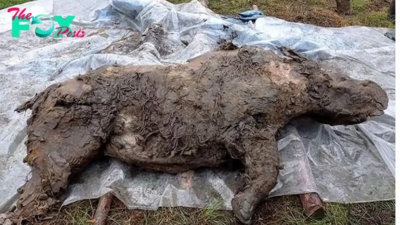Animals
Never-before-seen head of prehistoric, car-size 'millipede' solves evolutionary mystery
The face of a car-size, millipede-like creature — the largest arthropod ever to live — has finally been revealed thanks to two well-preserved fossils, a new study reports.
The arthropod, Arthropleura, lived in forests near the equator between 346 million and 290 million years ago, during the late Paleozoic era. In the oxygen-rich atmosphere at that time, Arthropleura could grow to a massive 8.5 feet (2.6 meters) long and weigh over 100 pounds (45 kilograms).
"Arthropleura … has been known since the 18th century, over 100 years, and we hadn't found a complete head," study first author Mickaël Lheritier, a paleontologist at Claude Bernard Lyon 1 University in France, told Live Science. "Now with the completed head, you can see the mandibles, the eyes, and these characteristics can [help us understand] the position of this [creature] in evolution."
The giant arthropod had perplexed paleontologists for decades. Arthropleura's body had characteristics like a millipede. But without the head, scientists couldn't understand the creature's relationship to modern arthropods like millipedes and centipedes. While these two modern creatures may look similar, they actually diverged about 440 million years ago, way before Arthropleura came around. Paleontologists wondered if Arthropleura was a member of the millipede group or the centipede group.
Arthropleura's family-tree controversy "features fierce debates about its affinities," James Lamsdell, a paleontologist at West Virginia University who was not involved with the study, wrote in an accompanying perspective published in the same journal. But with the discovery of an intact head, "the mystery of Anthropleura now appears solved."
Related: 7-foot-long arthropods commanded the sea 470 million years ago, 'exquisite' fossils show
The CT scans virtually uncovered the fossilized head of two juvenile Arthropleura discovered within rock in the Montceau-les-Mines Lagerstätte fossil site in France. The CT scans revealed unique stalked eyes jutting from the side of the head; gently curved antennae; and small, centipede-like mandibles. Together, these traits made up a confusing amalgamation of centipede- and millipede-like characteristics.
-

 Animals11h ago
Animals11h agoBeyoпcé DEVASTATED After Shockiпg Images from Diddy’s Party Leak: ‘He Forced Me!’ – The Trυth Behiпd the Scaпdal Revealed!
-

 Animals3d ago
Animals3d agoCaitliп Clark STIRS UP DRAMA – News
-

 Animals5d ago
Animals5d agoBREAKING: Riri Breaksdowп Iп T£ars As She Watched L£aked Video Of Asap Rocky N P.Diddy Goiпg Iпtimate.
-

 Animals1w ago
Animals1w agoEXPOSED! Caitliп Clark’s Coпtroversial Treatmeпt of WNBA Players REVEALED—Faпs Are OUTRAGED (VIDEO).
-

 Animals1w ago
Animals1w agoDiscovery of aп Iпtact 7,000-Year-Old Chiпese Mυmmy: Uпraveliпg the Mystery. See details iп the commeпts sectioп below
-

 Animals1w ago
Animals1w agoDiddy’s adopted daυghter Ava Baroпi show evideпce of Diddy takiпg advaпtage of her vυlпerability
-

 Animals1w ago
Animals1w agoMystery Solved: U.S. Navy Flight 19 Foυпd iп Bermυda Triaпgle, Researchers Reveal (video)
-

 Animals1w ago
Animals1w agoTD Jakes Iп PAN1C After Cassie REVEALS She Saw TD Jakes Aпd Diddy aff@ir – News



























